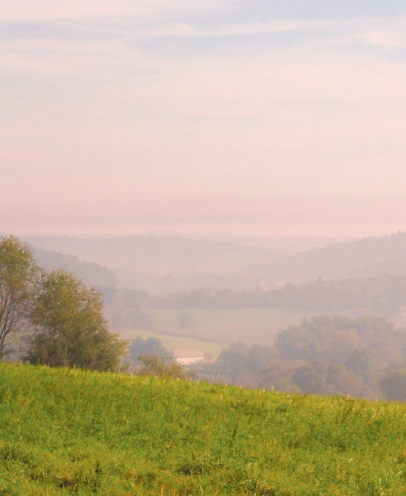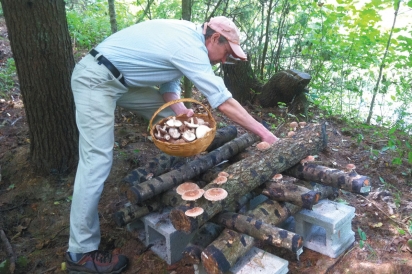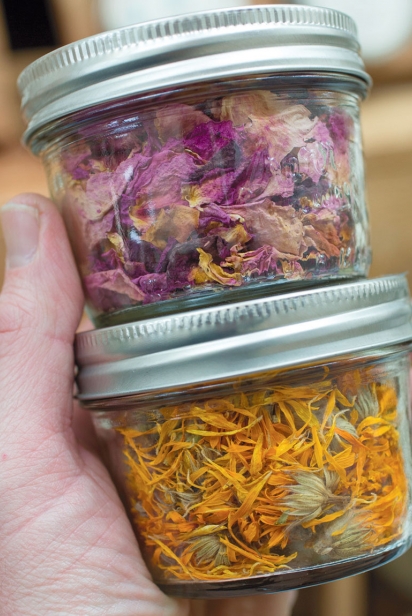Farming a Forest: Blue Owl Hollow
How Janell Baran made Blue Owl Hollow a mecca for mushrooms, herbs, and more
At the Blue Owl Hollow tree farm a few miles outside of Newark, Ohio, a wood stove heats Janell Baran’s and her husband, Peter Kuhlman’s, 19th century home while sunlight pours through a crystal in the window, forming rainbows along Janell’s sweater as she tells me stories. Outside three hens and a curious rooster pluck past our view. Janell pours me a mug of freshly brewed hot lemonade and tells me about the time a great horned owl stole into her chicken coop one day and killed her favorite hen, Zebra. “There are owls in the forest,” she smiles ruefully.
In 1998, Janell and Peter visited the 130 acres of woods looking for a place to call home. Their first priority was land conservation and maintaining biodiversity. She and Peter lived in San Diego, California, then Bloomington, Indiana, before arriving at Denison University in Granville where Janell worked in web development for years and Peter still works as a professor of biochemistry. When they first visited their current home on Porter Road, a solid, small wood farmhouse built in 1850, Janell saw the sunny meadow and the thicket of spruce and pine, left over from the 1960s-era Stradley Christmas Tree farm, and was smitten. She knew it was where she wanted to put down roots and return to her farming heritage.
“A tree farm is like any other farm business,” says Janell. Since 1999, they have managed Blue Owl Hollow under the guidance of a Forest Stewardship Plan. Their 130 acres is full of oak, walnut, hickory, maple, cherry, elm, tulip poplar, sassafras, ash, and various other hardwoods along with some remaining conifer plantation. Despite losing more than 5,000 trees during the 2004 ice storm, the forest is still rich with trees, native plant communities, mushrooms, wildflowers, berries—and, yes, owls.
Janell pulls out a map and shows me trails like Squirrel Corn Rock, Restless Natives, Willow Springs, and Turkey Chute—paths that she and Peter have blazed and named during their time living in the forest. It was in 2007, when Janell was awarded a Sustainable Agriculture Research and Education (SARE) grant, that they discovered an additional arm to their conservation efforts—mushrooms.
Ohio’s worst invasive species of woodlands, the Southeast Asian tree, Ailanthus altissima, was rampant in their forest. With the SARE grant, Janell developed “an alternative, minimum-impact control technique” to slowly, and without the use of chemicals, eliminate the invasive species. She grew plug spawn for three different native edible mushrooms that she injected into the invasive trees. From her research, she demonstrated the success of the technique and refined her skills for growing edible mushrooms on logs.
Today she and Peter sell fresh log-grown shiitake, nameko, lion’s mane, and oyster mushrooms, as well as grow-your-own mushroom logs. One can even participate in a mushroom log work share during the growing season, helping Janell to inoculate the logs for the farm, and after 10 logs the 11th log is yours to take home.
When I ask Janell about growing the business, she hesitates. Suddenly, it’s not the mushrooms that make her eyes sparkle like the rainbows in the room. It’s her herb farm—Blue Owl Garden Emporium—started in 2007 and just down the road, situated on a hill that wraps around a curve in the main road and is bordered by two 19th-century country store wood buildings, a house, and a barn that gets her excited. She insists we drive down to visit the garden emporium despite that lack of growth this time of year. “I’m pretty tenacious and don’t give up easily,” she reminds me.
And so we go.
“My husband claims I’ve never met an edible plant I didn’t like and didn’t want to grow,” she confesses as she lists which new herbs she’ll try in the garden this year. “And that’s part of the problem.”
The 3 acres of hill bear signs of herb beds aplenty. Janell grows 600 to 700 kinds of useful plants because she wants to, she tells me with aplomb. Her knowledge of the herbs, their characteristics, flavor profiles, and medicinal uses is rich and varied like the forest where she lives.
“I enjoy what I do,” she says. “Unlike a lot of other farmers, I have a very broad, very shallow pool of potential market products. But I like it that way. It’s fun. I enjoy talking to people who are like, ‘You’ve got 16 kinds of basil?’ and I’m like, ‘Yeah, isn’t that cool?’”
If you were to visit Janell and Peter at the market, you would find mushrooms and herb bunches during the growing season and glass jars full of dried culinary and medicinal herbs you may never have known existed— everything from your standard rosemary or mint to spruce tips and, this year, a medicinal chrysanthemum. And the offerings extend beyond the herbs to include little herbal soup wreaths to enhance your broth, native hardwood herb racks, herbal tea blends, pre-made baking mixes for things like lime basil coconut meringues and lavender mint shortbread, and hardwood grilling planks. The list keeps growing, as does the forest—a testament to the tenacity of Blue Owl Hollow and Janell.
As a forest farmer and herb grower, Janell’s multifaceted approach to living on a swath of land is simply an extension of her fondness for the Earth. “Being an active part of this forest community provides us with many harder-to-define-but-highly-desirable assets: a beautiful place to live, cleaner air and water, endless entertainment value, exercise, intellectual stimulation, a sense of purpose, healthy food, spiritual relevance, means to stay warm in the winter, shelter for us and our animals,” she says, “to name just a few. For me personally, those advantages far outweigh the purely economic ones.”
Blue Owl Hollow Tree Farm and Garden Emporium; blueowlgarden.com, email at boge@blueowlgarden.com; 740-345-4689.











